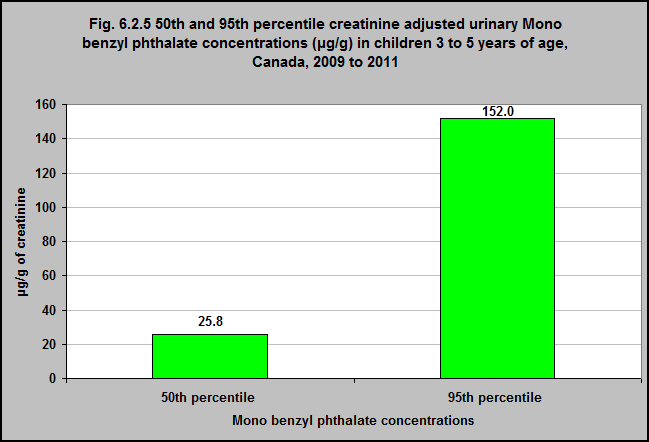50th and 95th percentile creatinine adjusted urinary Mono benzyl phthalate concentrations (μg/g) in children 3 to 5 years of age, Canada, 2009 to 2011

Source: CICH graphic created using data adapted from Statistics Canada. Canadian Health Measures Survey, 2009-2011, Custom runs.
Mono benzyl phthalate (MBzP) is the primary metabolite of benzyl butyl phthalate (BBP). Measures have been taken to reduce human exposure to BBP including Health Canada’s restrictions on the use of this phthalate in children’s toys and child-care products.1
One hundred percent of Canadians have urinary creatinine-adjusted mono-benzyl phthalate metabolite (MBzP) concentrations that meet or exceed the limit of detection. The median (50th percentile) creatinine-adjusted urinary mono-benzyl phthalate concentration among 3 to 5 year-olds in Canada is 25.8 μg/g of creatinine. The 95th percentile concentration for 3 to 5 year-old Canadians is 152 μg/g of creatinine.
3 to 5 year-olds have the highest concentration of all age groups.
1Phthalates Regulations. (Current to February 28, 2017). SOR/2010-298. Government of Canada. http://laws-lois.justice.gc.ca/PDF/SOR-2016-188.pdf– accessed March 20th, 2017.
Implications
There is some evidence that phthalates may be endocrine disruptors. Endocrine disruptors affect the functioning of hormones, which play important roles in many physiological processes. It is thought that endocrine disruptors might negatively affect a child’s development, behaviour, and reproductive health.2
Exposure to phthalates has been associated with other negative child health and well-being outcomes, including behaviour problems, attention deficit hyperactivity disorders and lower than average intelligence quotient (IQ) in children.2
2United States Environmental Protection Agency. (2013). America’s Children and the Environment, Third Edition. https://www.epa.gov/sites/production/files/2015-06/documents/ace3_2013.pdf – accessed March 12th, 2017.
